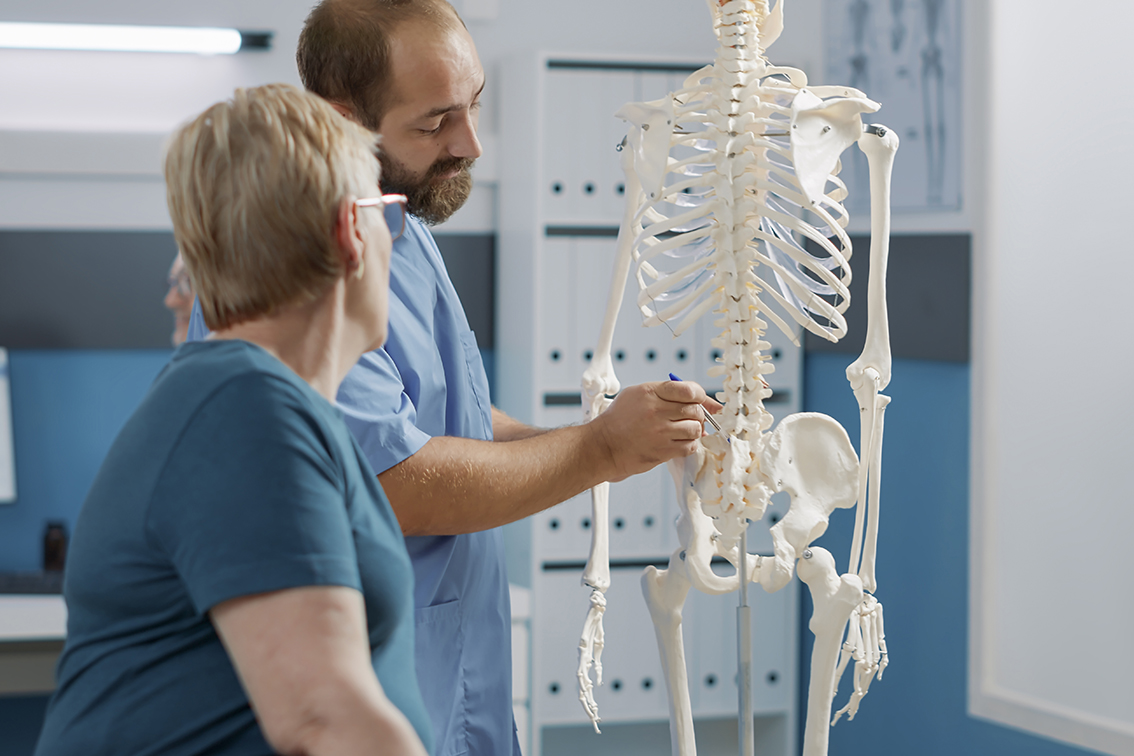
The spinal cord is an essential part of the human body, connecting the brain to the peripheral nerves, as well as connecting the peripheral nerves to the brain. September is Spinal Cord Injury Awareness month, so we thought it would be fitting to do a blog post giving you an overview of the spinal cord and spinal cord injuries.
Commonly, people refer to the spinal cord and vertebral column as the ‘spine’. The spinal column forms part of the skeletal system, whereas the spinal cord is part of the nervous system. When we refer to the nervous system, we can often divide it into two segments – the central nervous system (brain and spinal cord) and peripheral nervous system (all other nerves in the body).
The spinal cord is a long cylindrical structure of nervous tissue, extending from the base of the brain down to the lumbar spine. Towards its’ end the spinal cord tapers, with the end of the spinal cord known as the cauda equina. There are two rows of nerve roots on either side of the spinal cord, these nerve roots join to 31 pairs of spinal nerves. Spinal nerves are the connection between the spinal column and the rest of the body, allowing communication between the brain and body for both sensory information and motor commands. As the spinal cord is of such importance, the body is designed to protect this delicate structure. Protection of the spinal cord is done by the back bones (vertebrae / spinal column), 3 sheath layers known as the meninges and cerebrospinal fluid.
The spinal cord can be segmentally organised, there are 31 segments which are defined by 31 pairs of nerves exiting the spinal cord. These divisions include cervical (8), thoracic (12), lumbar (5), sacral (5) and coccygeal (1). All spinal nerves, except in the cervical spine, exit below their corresponding vertebrae. Additionally, the spinal cord has two tracts, the ascending tract where information from the peripheral nerves travels up towards the brain for processing (i.e. carrying sensory information) and the descending tract which travels from the brain down to the peripheral nerves (i.e. carrying motor commands).
The anatomy of the spinal cord is complex, and when looking at all the fine details it leaves us in amazement of its’ functioning. The spinal cord, like any bodily region, is unfortunately susceptible to injury…
A spinal cord injury (CSI), as the name implies, occurs when there is damage to the spinal cord. Spinal cord injuries not only impact one physically, but also mentally, functionally, and socially.
A spinal cord injury can occur at any point of the spinal cord, therefore making them difficult to categorise. In general, spinal cord injuries can be defined in terms of two categories: where the injury occurred and the severity. The lowest remaining functional level of your spinal cord after an injury is referred to as the level of injury. And in terms of severity, we refer to ‘completeness’ of the injury, either being partial or complete SCI:
SCI’s can either be traumatic or non-traumatic in nature. Traumatic SCIs include a specific event causing a blow to the spinal cord through spinal fractures or dislocations, crushing or compression. With regards to traumatic SCIs, there is the potential further damage can be caused through bleeding, inflammation, and fluid accumulation. Non-traumatic spinal cord injuries may be due to cancerous tumours, arthritis, inflammatory conditions, disc degeneration and spinal stenosis.
The most common causes of spinal cord injuries include motor vehicle accidents, falls, acts if violence, sports/recreational activities, or underlying diseases.
The symptoms and effects of a SCI is dependent on the level of the injury, as different levels of the spinal cord control different bodily functions and regions.
The symptoms and effects seen with spinal cord injuries include loss of movement ability, loss of or altered sensations, loss of bowel and/or bladder control, reflex exaggeration, spasticity, and difficulty breathing/coughing. SCIs are multifactorial, affecting various aspects of life from breathing to muscle tone, from circulation to pain. These symptoms and effects disrupt both movement ability and perception of the world, effecting one’s ability to complete everyday tasks.
Ways to keep the spinal cord and vertebral column healthy include following a nutritious diet, regular exercise, practising good posture, sleep in supportive positions and following a healthy lifestyle.
Unfortunately, there is currently no cure for a spinal cord injury however in the meantime treatments and rehabilitation allow those with SCI’s the optimise their function and improve their quality of life.
Exercise participation is important for us all. Those with SCIs may experience challenges when it comes to ability to participate in exercise, and this is where the biokinetics profession comes in.
Exercise ability for those with a SCI is dependent on the level of the spinal cord injury and the patient’s ability and needs. With spinal cord injuries, our focus is maintaining strength and mobility with particular focus on daily activities.
There is continual research on the spinal cord and treatments for spinal cord injuries, in hope that one day doctors may offer a spinal cord repair. Exercise rehabilitation currently offers both functional improvement, complication prevention and overall quality of life improvement for those with spinal cord injuries.

Rebecca holds a Bachelor of Biokinetics from the University of Johannesburg (UJ). She is passionate about rehabilitation and health management, especially in those with chronic diseases and disabilities.
She is also qualified in Sports massage (HFPA) and CPR.
Connect on LinkedIn
Should you require further information or assistance, please don’t hesitate to make contact with us at our Sandton or Cape Town branchs.
Burke Rehabilitation Hospital. (2022). The Benefits of Exercise after Spinal Cord Injury. Available from: https://www.burke.org/blog/2015/10/the-benefits-of-exercise-after-spinal-cord-injury/56
Cleveland Clinic. (2021). Spinal Cord. Available from: https://my.clevelandclinic.org/health/body/21946-spinal-cord
Mayo Clinic. (2021). Spinal cord injury. Available from: https://www.mayoclinic.org/diseases-conditions/spinal-cord-injury/symptoms-causes/syc-20377890
Neuroscience Online. (2020). Chapter 3: Anatomy of the Spinal Cord. Available from: https://nba.uth.tmc.edu/neuroscience/m/s2/chapter03.html